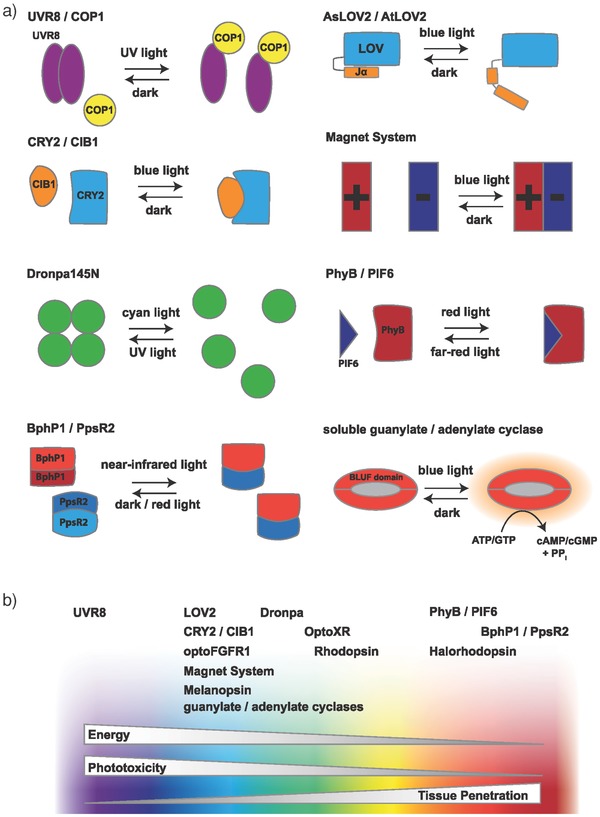Figure 2.

Nonopsin photoactivatable proteins: a) naturally occurring and engineered photoactivatable proteins can be activated by light of different wavelengths ranging from ultraviolet to infrared. Different mechanisms of activation are known: association, dissociation, uncaging, or unhinging as well as direct photoactivation of enzymes. For example, UV‐B light triggers a stress response in plants which is mediated by dimerization of UVR8 proteins. LOV domains from AsLOV2 and AtLOV2 are stimulated by blue light, causing the then‐unhinged C‐terminal alpha helix Jα to bend outward, activating a kinase domain in the natural protein. The CRY2 and CIB1 pair mediates responsiveness to blue light in plants via a blue light–induced heterodimerization mechanism. CRY2 also has a tendency to cluster into homo‐oligomers upon activation. In the Magnet system, engineered variants of the VVD domains are either positively or negatively charged. Upon exposure to blue light, they only bind to each other, but do not form homodimers. The Dronpa145N mutant of the fluorescent protein Dronpa was found to form homotetramers in the dark that dissociate on exposure to cyan light, just like the wild‐type protein, but at lower concentrations. UV light reverses this reaction. The photoreceptor protein PhyB binds to its partner PIF6. Far‐red light–induced dissociation of the complex reverses this interaction. The bacteriophytochrome BphP1 forms homodimers in the dark, but forms heterodimers with PpsR2 upon exposure to near‐infrared light. This transition is reversible and the backward reaction can be boosted by exposure to red light. Soluble guanylate cyclases are a class of photoactivatable enzymes that are activated by blue light through their BLUF (blue light sensor using FAD) domain. b) Photosensors can be activated by a specific wavelength in the UV–vis spectrum. While shorter wavelengths have higher energy, they also show greater phototoxicity, damaging DNA and perturbing pathways that involve chromophore‐binding proteins. Additionally, tissue penetration is limited for blue light compared to red light. In the retina as well as in many microorganisms, there are opsins for every section of the visible spectrum. However, most light‐inducible systems available for molecular biology are activated exclusively in the blue and green ranges.
